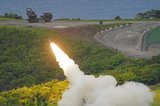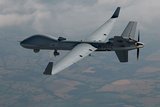Taiwan unveils new drone as China tensions mount
Taiwan's navy showed off its latest long-range surveillance drone Thursday as the island's outgunned armed forces push to counter China's increasingly muscular rhetoric and military exercises.
China still sees Taiwan as part of its territory to be reunified, despite the two sides being ruled separately since they split in 1949 after a civil war.
Beijing has said it will not hesitate to use force if Taipei formally declares independence, or in the case of external intervention - including by the US, the island's most powerful unofficial ally.
The already terse relationship between the two sides got off to an even rockier start in the new year after Chinese President Xi Jinping gave a landmark speech describing the island's unification with the mainland as 'inevitable'.
Taiwan's president Tsai Ing-wen hit back saying her people would never relinquish their democratic freedoms, an unusually robust response that saw her receive a bump in the polls after a gruelling few months in which her party lost heavily in local elections.
The island's military has hosted multiple drills since Xi's speech, emphasising what it says is a readiness to counter any invasion.
On Thursday, the navy showed off its new, long-range surveillance drone, the Rui Yuan (Sharp Hawk), which officials said can fly for 12 hours and was now helping to monitor movements in the disputed strait between Taiwan and China.
'The drones are now an irreplaceable part of our reconnaissance strategy,' Taiwan defence ministry spokesperson Chen Chung-chi told AFP. 'They are our primary option for activities in the strait.'
The self-ruled island has its own currency, flag and government, but is not recognised as an independent state by the UN.
As a result, it struggles to procure key military equipment from many major powers who are fearful of angering Beijing. Instead, it has turned to local manufacturers, particularly for drones and missiles.
'The use of more locally-made drones demonstrates Taiwan's defence self-sufficiency and helps boost its reconnaissance capabilities,' Wang Kao-cheng, a military analyst at Tamkang University, told AFP.
Taiwan's American F-16 and ageing French-made Mirage fighter jets are being increasingly called upon to respond to military movements from China, with some analysts warning the fleet is getting worn down and lacking crucial spare parts.
Lin Ming-chang, an executive officer with Taiwan's navy, said drones were particularly cost-effective for surveillance.
'A pilot, when he flies, has to come back in two hours. But not the Rui-yuan drone. We can stay up in the air for up to 12 hours,' he said.
'In operating terms, both when it comes to fuel or machine parts, the drone can operate way longer than manned aircraft.'
The navy also unveiled a hand-launched surveillance drone on Thursday called The Cardinal, which it said could stay airborne for an hour.
More from Uncrewed Vehicles
-
![What's next for the Pentagon after the Replicator programme?]()
What's next for the Pentagon after the Replicator programme?
Although the Replicator initiative has made several accomplishments, there are still multiple gaps to plug across the US Department of Defense (DoD) and its services.
-
![Cummings Aerospace showcases Hellhound loitering munition designed for US Army’s LASSO programme (video)]()
Cummings Aerospace showcases Hellhound loitering munition designed for US Army’s LASSO programme (video)
Cummings Aerospace presented its turbojet-powered Hellhound loitering munition at SOF Week 2025, offering a man-portable solution aligned with the US Army’s LASSO requirements.
-
![SOF Week 2025: PDW unveils attritable FPV drone for SOF operations at scale]()
SOF Week 2025: PDW unveils attritable FPV drone for SOF operations at scale
PDW has revealed its Attritable Multirotor First Person View drone at SOF Week 2025, offering special operations forces a low-cost, rapidly deployable platform for strike and ISR missions, inspired by battlefield lessons from Ukraine.
-
![SOF Week 2025: Teledyne FLIR white paper provides guidance on reusable loitering munitions]()
SOF Week 2025: Teledyne FLIR white paper provides guidance on reusable loitering munitions
Teledyne FLIR is highlighting the emerging requirements for 'recoverable and re-usable' loitering munitions across the contemporary operating environment during this week’s SOF Week conference in Tampa, Florida.
-
![SOF Week 2025: Kraken Technology group debuts K3 Scout USV in North America]()
SOF Week 2025: Kraken Technology group debuts K3 Scout USV in North America
High-performance maritime industry player Kraken Technology Group, based in the UK, has used the SOF Week conference in Tampa, Florida this week to debut its K3 Scout uncrewed surface vessel (USV) to the North American market.
-
![Palladyne AI and Red Cat to demonstrate capabilities for autonomous drone swarms to the US military]()
Palladyne AI and Red Cat to demonstrate capabilities for autonomous drone swarms to the US military
Red Cat and Palladyne AI recently conducted a cross-platform collaborative flight involving three diverse heterogeneous drones.

























